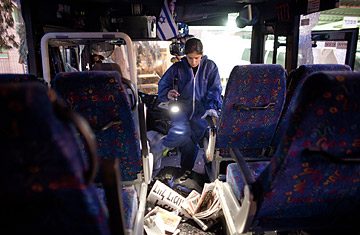
An Israeli police forensic officer inspects Bus 392 inside a police station following a gun attack on Aug. 18, 2011, in Eilat, Israel.
A month after an unusual terrorist attack killed eight Israelis along a desert highway approaching the Red Sea, the incident remains shrouded in mystery, especially in Gaza, where Israeli officials insist the complex, military-style attack was orchestrated, though no group has taken responsibility. "Usually the problem is, more than one group takes credit after a successful operation," says Taher al-Nunu, a spokesman for Hamas, the militant group that governs Gaza. Hamas had immediately denied knowledge of the attack and hurriedly surveyed the other militant groups operating in the enclave. "All of them denied it," al-Nunu says.
Among them was the Popular Resistance Committees (PRC), the group Israel almost immediately blamed for the attack as it promptly launched what it called a reprisal strike. Before the fighting was finished in the desert outside the resort city of Eilat, a missile from an Israeli drone exploded outside a house in Rafah, near the Egyptian border. The PRC's top commander and two aides were killed, as was a 2-year-old child.
Afterward, the group continued to deny responsibility — also unusual in a society that celebrates lives lost opposing the Israeli occupation. As a senior Hamas official put it, with a frown: "After their leaders were killed, you would expect people to be proud."
Israeli security officials tell TIME that the link to the PRC was as clear as the orders they monitored in real time from Gaza to the Sinai Peninsula, where the militants waited in ambush. In a new detail, one official states that two of the five bodies recovered after the fighting have been identified as Gaza residents. The official did not say how the identity was confirmed, which will do little to end speculation about the incident.
"If the Israelis have any proof, give it," says Ahmed Yusuf, a former Hamas official who now runs a Gaza think tank. "I met with these people for the Popular Resistance. They said, 'We want to distance ourselves from what happened in Eilat and wondered why they were threatening us.' "
Pointing to Gaza are the paraphernalia found at the scene — flex cuffs and chloroform — indicating that militants hoped to kidnap an Israeli. Kidnapping is a primary goal for militants, given Israel's history of releasing hundreds of Palestinian prisoners in exchange for one hostage.
Pointing away from Gaza is the absence, apart from the funerals of the PRC leaders, of any sign of mourning for martyred sons — almost impossible to hide in so small a place — and the relative sophistication of the attack itself, "a very complex, very strange operation," in the words of one militant. As many as a dozen attackers laid a midday ambush Aug. 18 on an Israeli highway that parallels the border with the Sinai Peninsula, a part of Egypt accessible from Gaza that has been especially lawless since the downfall of Hosni Mubarak, when police abandoned their post. Assailants fired automatic weapons and rocket-propelled grenades (originally thought to be missiles) at civilian cars and buses. One bus was incinerated when an attacker, moving with what witnesses described as frantic speed, climbed aboard and detonated a suicide vest; only the driver had been on board.
